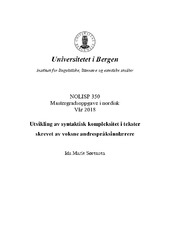| dc.contributor.author | Sørensen, Ida Marie Moklef | |
| dc.date.accessioned | 2018-07-02T07:34:04Z | |
| dc.date.available | 2018-07-02T07:34:04Z | |
| dc.date.issued | 2018-06-16 | |
| dc.date.submitted | 2018-06-15T22:00:08Z | |
| dc.identifier.uri | https://hdl.handle.net/1956/17854 | |
| dc.description.abstract | This thesis is written within the field of Second Language Acquisition. The thesis investigates syntactic complexity in written assignments produced by learners at different Common reference levels. It compares syntactic constructs in the texts, and examines whether or not there are signs of development between student texts on level A2, B1 and B2. The comparison is based on both quantitative and qualitative surveys. The quantitative survey consists of a registration of a number of analytical units, indices, descriptive- and inferential statistics. The qualitative survey is a close reading of selected texts. The combination of surveys provides information about variations and differences both in and across the text material at the three reference levels. The thesis is based on theory from the complexity-, accuracy- and fluency tradition (CAF) and central studies on syntactic complexity. Berggreen and Sørland’s study from 2016 is central for this thesis. Based on theory and previous studies I have chosen analytical constructs that I register in the text material, which describe the syntactic complexity of the texts. I investigate the length of T-units and maximal noun phrases, amount of coordination and subordination, and the amount of syntactically incorrect T-units. Differences and/or similarities between the text at different levels can show development in syntactic complexity. The survey shows a partial linear development in some of the measurements, especially the T-unit length, noun phrase length and the number of subordinated clauses, where the measurements increases between the texts on level A2, B1 and B2. In addition, the study show a partial linear development in the measurements of syntactically incorrect t-units and coordination, where the values decreases (with some exceptions) the higher the level. Some of the differences are significant, but often only between level A2 and B2, with the exception of the measurement of syntactically incorrect t-units, where the differences are significant between each level. In the other measurements, apart from «ordinary» coordination of t-units, the differences between texts on level B1 and level B2 are minor. The close reading and the measurements of variation show that there are differences among the individual learners on the same reference levels. These measurements show, like the quantitative results, some increase in development of syntactic complexity between different levels. | en_US |
| dc.description.abstract | Denne masteroppgaven er skrevet innenfor fagfeltet norsk som andrespråk og undersøker syntaktisk kompleksitet i tekster på ulike ferdighetsnivåer (A2, B1 og B2) i Det felles europeiske rammeverket for språk. Læring, undervisning, vurdering. Formålet er å undersøke om det er utvikling i syntaktisk kompleksitet mellom tekstene på ulike nivåer. Sammenligningen bygger på både kvantitative og kvalitative undersøkelser. Den kvantitative undersøkelsen består av registering av analytiske enheter, indekser og deskriptiv- og inferensiell statistikk. Den kvalitative undersøkelsen er en næranalyse av utvalgte tekster. Kombinasjonen av disse undersøkelsene gir informasjon om variasjon og forskjeller både innad og på tvers i tekstmaterialet på de ulike ferdighetsnivåene. Oppgaven bygger på teori fra kompleksitet-, korrekthet- og flyttradisjonen (CAF) og sentrale studier om syntaktisk kompleksitet, og studiet til Berggreen og Sørland (2016) står veldig sentralt i denne oppgaven. Ut fra teori og tidligere studier har jeg valgt ut variabler som jeg registrerer i materialet, som viser den syntaktiske kompleksiteten i tekstene. Variablene er analytiske enheter som kartlegger t-enhetslengde, koordinering, leddsetninger, fraseutbygging og andelen av syntaktisk ukorrekte t-enheter. Forskjeller og/eller likheter mellom tekstene på ulike nivåer kan vise tendenser til hvordan utviklingen av syntaktisk kompleksitet er. Analysene viser en delvis lineær utvikling i noen av målingene, særlig t-enhetslengde, substantivfraseomfang og underordningsgrad, som stiger mellom tekstene på nivå A2 til B1, til B2. I tillegg viser analysene en delvis lineær utvikling i målingene antall syntaktisk ukorrekte t-enheter og koordinering, hvor tallverdiene synker (med unntak) desto høyere nivå. Noen av forskjellene er signifikante, men ofte kun mellom nivå A2 og B2, med unntak av syntaktisk ukorrekte t-enheter, der forskjellene er signifikante mellom hvert nivå. I de andre målingene, sett bort fra ordinær koordinering av t-enheter, er forskjellene mellom tekstene på nivå B1 og B2 små. Næranalysene og variasjonsmålene viser at det er en del forskjeller blant enkeltinformantene på likt ferdighetsnivå, men disse undersøkelsene viser i likhet med de kollektive resultatene at det er tendenser til utvikling i syntaktisk kompleksitet mellom ulike ferdighetsnivåer. | en_US |
| dc.language.iso | nob | eng |
| dc.publisher | The University of Bergen | eng |
| dc.subject | syntaktisk kompleksitet | eng |
| dc.subject | syntaksutvikling | eng |
| dc.subject | CAF | eng |
| dc.subject | andrespråksinnlærere | eng |
| dc.title | Utvikling av syntaktisk kompleksitet i tekster skrevet av voksne andrespråksinnlærere | eng |
| dc.title.alternative | Development of syntactic complexity in texts written by adult second language learners | eng |
| dc.type | Master thesis | |
| dc.date.updated | 2018-06-15T22:00:08Z | |
| dc.rights.holder | Copyright the Author. All rights reserved | eng |
| dc.description.degree | Mastergradsoppgave i nordisk | |
| dc.description.localcode | NOLISP350 | |
| dc.subject.nus | 711123 | eng |
| fs.subjectcode | NOLISP350 | |
| fs.unitcode | 11-21-0 | |
